change wheel CHEVROLET MONTE CARLO 1995 5.G Owners Manual
[x] Cancel search | Manufacturer: CHEVROLET, Model Year: 1995, Model line: MONTE CARLO, Model: CHEVROLET MONTE CARLO 1995 5.GPages: 324, PDF Size: 16.74 MB
Page 135 of 324

Downloaded from www.Manualslib.com manuals search engine The anti-lock system can change the brake pressure faster
than any driver could. The computer is programmed to
make the
most of available tire and road conditions.
Here’s how anti-lock works. Let’s say the road is wet.
You’re driving safely. Suddenly an animal jumps out
in
front of you.
You slam on the brakes. Here’s what happens with
ABS.
A computer senses that wheels are slowing down. If one
of the wheels
is about to stop rolling, the computer will
separately work the brakes at each front wheel and at the
rear wheels.
You can steer around the obstacle while braking hard.
As you brake, your computer keeps receiving updates on
wheel speed and controls braking pressure accordingly.
4-7
Page 136 of 324

Downloaded from www.Manualslib.com manuals search engine Remember: Anti-lock doesn’t change the time you need
to get your foot up to the brake pedal. If you get too
close to the vehicle in front of you, you won’t have time
to apply your brakes if that vehicle suddenly slows or
stops. Always leave enough room up ahead
to stop, even
though
you have anti-lock brakes.
To Use Anti-Lock
Don’t pump the brakes. Just hold the brake pedal down
and let anti-lock work for you.
You may feel the system
worhng, or you may notice some noise, but this is
normal. When your anti-lock system
is adjusting brake
pressure to help avoid a braking skid, the
LOW TRAC
light will come on. See “Anti-Lock Brake System
Active Light” in the Index.
Braking in Emergencies
Use your anti-lock braking system when you need to.
With anti-lock, you can steer and brake at the same
time.
In many emergencies, steering can help you more
than even the
very best braking.
Steering
Power Steering
If you lose power steering assist because the engine
stops or the system is not functioning, you can steer but
it will take much more effort.
Steering Tips
Driving on Curves
It’s important to take curves at a reasonable speed.
A
lot of the “driver lost control” accidents mentioned on
the news happen on curves. Here’s why:
Experienced driver
or beginner, each of us is subject to
the same laws of physics when driving on curves. The
traction of the tires against the road surface makes
it
possible for the vehicle to change its path when you turn
the front wheels. If there’s no traction, inertia will keep
the vehicle going in the same direction. If you’ve ever
tried to steer
a vehicle on wet ice, you’ll understand this.
Page 140 of 324
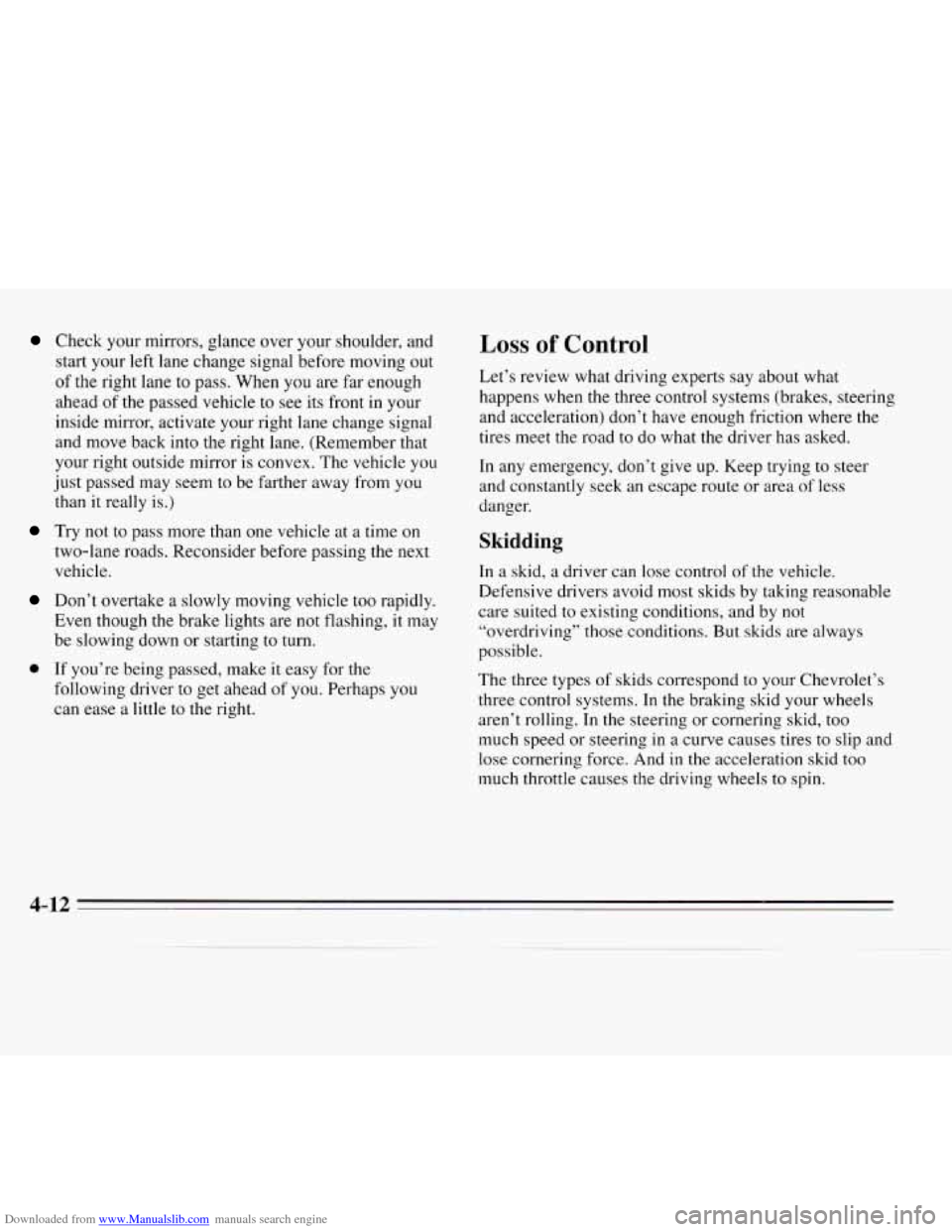
Downloaded from www.Manualslib.com manuals search engine Check your mirrors, glance over your shoulder, and
start your left lane change signal before moving out
of the right lane to pass. When you are far enough
ahead of the passed vehicle
to see its front in your
inside mirror, activate your right lane change signal
and move back into the right lane. (Remember that
your right outside mirror is convex. The vehicle you
just passed may seem to be farther away from you
than it really
is.)
Try not to pass more than one vehicle at a time on
two-lane roads. Reconsider before passing the next
vehicle.
Don’t overtake a slowly moving vehicle too rapidly.
Even though the brake lights are not flashing, it may
be slowing down or starting to turn.
0 If you’re being passed, make it easy for the
following driver
to get ahead of you. Perhaps you
can ease a little to the right.
Loss of Control
Let’s review what driving experts say about what
happens when the three control systems (brakes, steering and acceleration) don’t have enough friction where the
tires meet the road to do what the driver has asked.
In any emergency, don’t give up. Keep trying to steer
and constantly seek an escape route
or area of less
danger.
Skidding
In a skid, a driver can lose control of the vehicle.
Defensive drivers avoid most skids by taking reasonable
care suited to existing conditions, and by not
“overdriving” those conditions. But
skids are always
possible.
The three types of skids correspond to your Chevrolet’s
three control systems. In the braking skid your wheels
aren’t rolling. In the steering or cornering skid, too
much speed or steering in a curve causes tires
to slip and
lose cornering force. And
in the acceleration skid too
much throttle causes the driving wheels to spin.
4-12
Page 156 of 324

Downloaded from www.Manualslib.com manuals search engine Towing a Trailer
NOTICE:
Pulling a trailer improperly can damage your
vehicle and result in costly repairs not covered by
your warranty.
To pull a trailer correctly, follow
the advice in this part, and see your Chevrolet dealer for important information about towing a
trailer with your vehicle.
Your vehicle can tow a trailer. To identify what the
vehicle trailering capacity is for your vehicle, you
should read the information in “Weight of the Trailer’’
that appears later in this section. But trailering is
different than just driving your vehicle by itself.
Trailering means changes in handling, durability, and
fuel economy. Successful, safe trailering takes correct
equipment, and it has to be used properly.
That’s the reason for this part. In
it are many
time-tested, important trailering tips and safety rules.
Many of these are important for your safety and that of
your passengers.
So please read this section carefully
before you pull
a trailer.
Load-pulling components such
as the engine, transaxle,
wheel assemblies, and tires are forced to work harder
against the drag of the added weight. The engine is
required to operate at relatively higher speeds and under
greater loads, generating extra heat. What’s more, the
trailer adds considerably to wind resistance, increasing
the pulling requirements.
Page 161 of 324
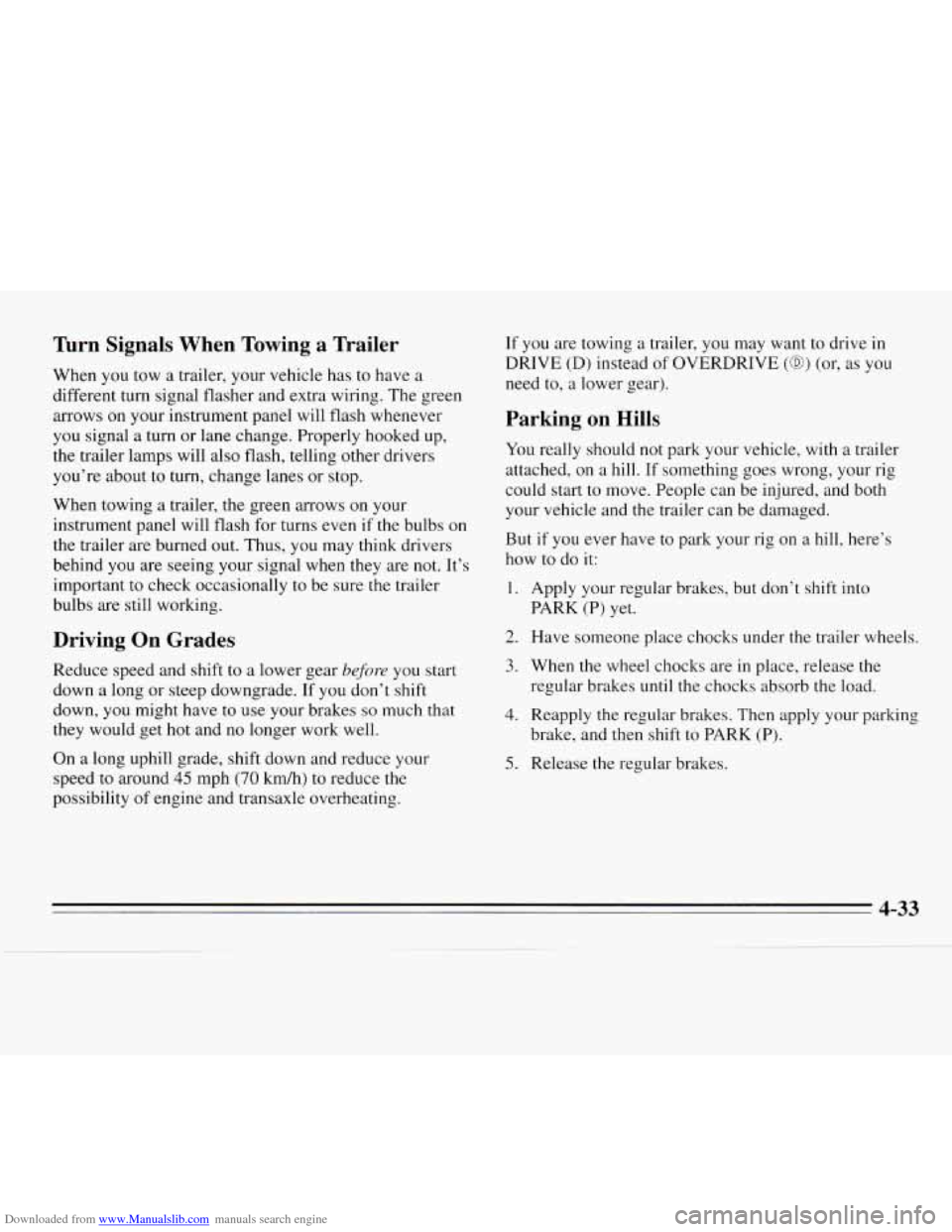
Downloaded from www.Manualslib.com manuals search engine Turn Signals When Towing a Trailer
When you tow a trailer, your vehicle has to have a
different
turn signal flasher and extra wiring. The green
arrows on your instrument panel will flash whenever
you signal a turn or lane change. Properly hooked up,
the trailer lamps will also flash, telling other drivers
you’re about to turn, change lanes or stop.
When towing a trailer, the green arrows
on your
instrument panel will flash for turns even if the bulbs on
the trailer are burned out. Thus, you may think drivers
behind
you are seeing your signal when they are not. It’s
important to check occasionally to be sure the trailer
bulbs are still working.
Driving On Grades
Reduce speed and shift to a lower gear before you start
down a long or steep downgrade. If you don’t shift
down, you might have to use your brakes
so much that
they would get hot and no longer work well.
On a long uphill grade, shift down and reduce your
speed
to around 45 mph (70 km/h) to reduce the
possibility of engine and transaxle overheating. If
you are towing a trailer, you may want to drive in
DRIVE (D) instead
of OVERDRIVE (0) (or, as you
need to, a lower gear).
Parking on Hills
You really should not park your vehicle, with a trailer
attached, on
a hill. If something goes wrong, your rig
could start to move. People can be injured, and both
your vehicle and the trailer can be damaged.
But
if you ever have to park your rig on a hill, here’s
how to do it:
1. Apply your regular brakes, but don’t shift into
PARK (P) yet.
2. Have someone place chocks under the trailer wheels.
3. When the wheel chocks are in place, release the
regular brakes until the chocks absorb the load.
4. Reapply the regular brakes. Then apply your parking
brake, and then shift to PARK (P).
5. Release the regular brakes.
4-33
Page 169 of 324

Downloaded from www.Manualslib.com manuals search engine Towing Your Vehicle
Try to have a GM dealer or a professional towing
service tow your Chevrolet. The usual towing
equipment is:
A. Sling-type Tow Truck
B. Wheel-lift Tow Truck
C. Car Carrier If
your vehicle has been changed or modified since it
was factory-new
by adding aftermarket items like fog
lamps, aero skirting,
or special tires and wheels, these
instructions and illustrations may not be correct.
Before you do anything, turn on the hazard warning
flashers.
When
you mil, tell the towing service:
0 That your vehicle cannot be towed from the front or
rear with sling-type equipment.
That your vehicle has front-wheel drive.
The make, model, and year of your vehicle.
0 Whether you can still move the shift lever.
If there was an accident, what was damaged.
When the towing service arrives, let the tow operator
know that this manual contains detailed towing instructions and illustrations. The operator may want
to
see them.
5-7
Page 184 of 324
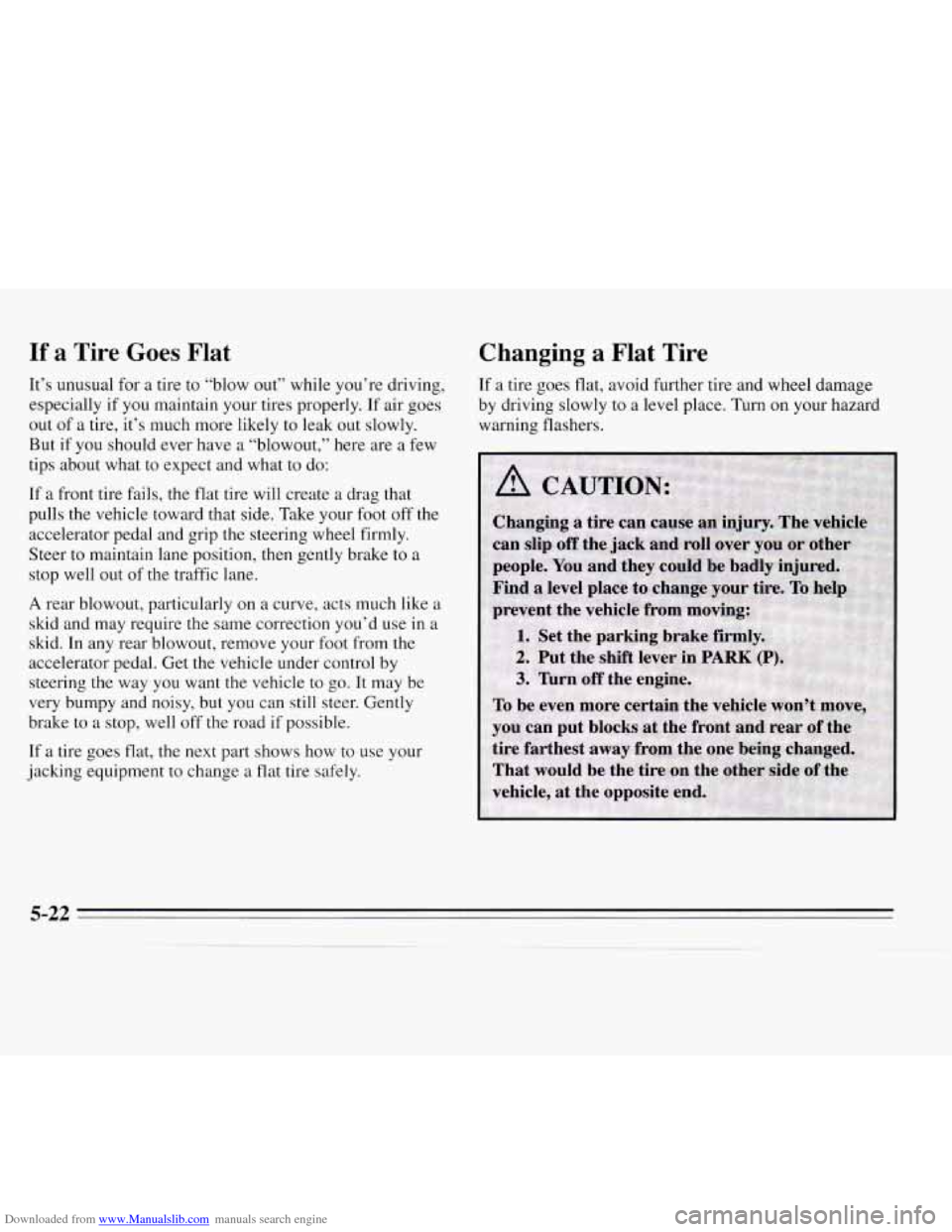
Downloaded from www.Manualslib.com manuals search engine If a Tire Goes Flat
It’s unusual for a tire to “blow out” while you’re driving,
especially
if you maintain your tires properly. If air goes
out of a tire, it’s much more likely to leak out slowly.
But if you should ever have a “blowout,” here are a few
tips about what to expect
and what to do:
If a front tire fails, the flat tire will create a drag that
pulls the vehicle toward that side. Take your foot
off the
accelerator pedal and grip
the steering wheel firmly.
Steer to maintain lane position, then gently brake to a
stop well out of the traffic lane.
A rear blowout, particularly on a curve, acts much like a
skid and may require the same correction you’d use in
a
skid. In any rear blowout, remove your foot from the
accelerator pedal. Get the vehicle under control by
steering the way you want the vehicle to go. It may be
very bumpy and noisy, but you can still steer. Gently
brake to a stop, well off
the road if possible.
If
a tire goes flat, the next part shows how to use your
jacking equipment to change
a flat tire safely.
Changing a Flat Tire
If a tire goes flat, avoid further tire and wheel damage
by driving slowly to a level place.
Turn on your hazard
warning flashers.
5-22
Page 316 of 324
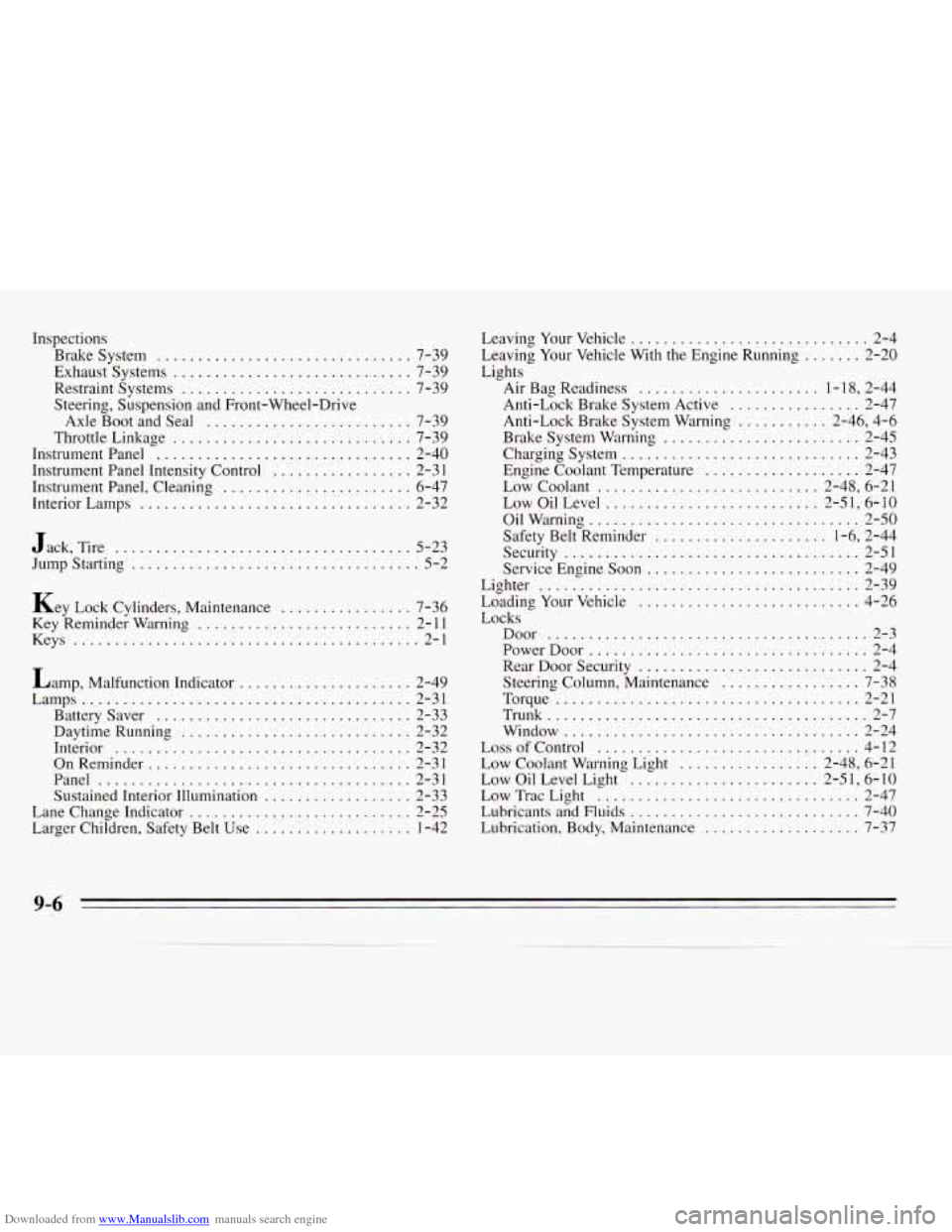
Downloaded from www.Manualslib.com manuals search engine Inspections Brakesystem
............................... 7-39
Exhaust Systems
............................. 7-39
Restraint Systems
............................ 7-39
Steering. Suspension and Front-Wheel-Drive
Axle Boot and Seal
......................... 7-39
Throttle Linkage
............................. 7-39
InstrumentPanel
............................... 2-40
Instrument Panel Intensity Control
................. 2-3 1
Instrument Panel. Cleaning ....................... 6-47
Interior Lamps
................................. 2-32
Jack. Tire
.................................... 5-23
Jump Starting
................................... 5-2
Key Lock Cylinders. Maintenance ................ 7-36
Key Reminder Warning .......................... 2- 1 1
Keys
.......................................... 2-1
Lamp. Malfunction Indicator
..................... 2-49
Lamps
........................................ 2-31
Battery Saver
............................... 2-33
Daytime
Running ............................ 2-32
Interior
.................................... 2-32
OnReminder
................................ 2-31
Panel
...................................... 2-31
Sustained Interior Illumination
.................. 2-33
Lane Change Indicator
........................... 2-25
Larger Children. Safety Belt Use
................. 1-42 Leaving
Your Vehicle
............................. 2-4
Leaving Your Vehicle With the Engine Running
....... 2-20
Lights Air Bag Readiness
...................... 1 . 18. 2-44
Anti-Lock Brake System Active
................ 2-47
Anti-Lock Brake System Warning
........... 2.46. 4.6
Brake System Warning
........................ 2-45
Engine Coolant Temperature
................... 2-47
Low Coolant
........................... 2-48. 6-21
Low Oil Level
.......................... 2-5 1. 6- 10
Oil Warning ................................. 2-50
Safety Belt Reminder
..................... 1-6. 2-44
Security
.................................... 2-51
Service Engine Soon
.......................... 2-49
Lighter
....................................... 2-39
Loading Your Vehicle
........................... 4-26
Locks Door
....................................... 2-3
PowerDoor .................................. 2-4
Rear Door Security
............................ 2-4
Steering Column. Maintenance
................. 7-38
Torque
..................................... 2-21
Trunk
....................................... 2-7
Window
.................................... 2-24
Loss of Control
................................ 4-12
Low Coolant Warning Light
................. 2.48. 6-21
Low Oil Level Light
....................... 2-5 1. 6- 10
Low Trac Light ................................ 2-47
Lubricants and Fluids
............................ 7-40
Lubrication. Body. Maintenance
................... 7-37
Charging
System
............................. 2-43
9-6
Page 321 of 324
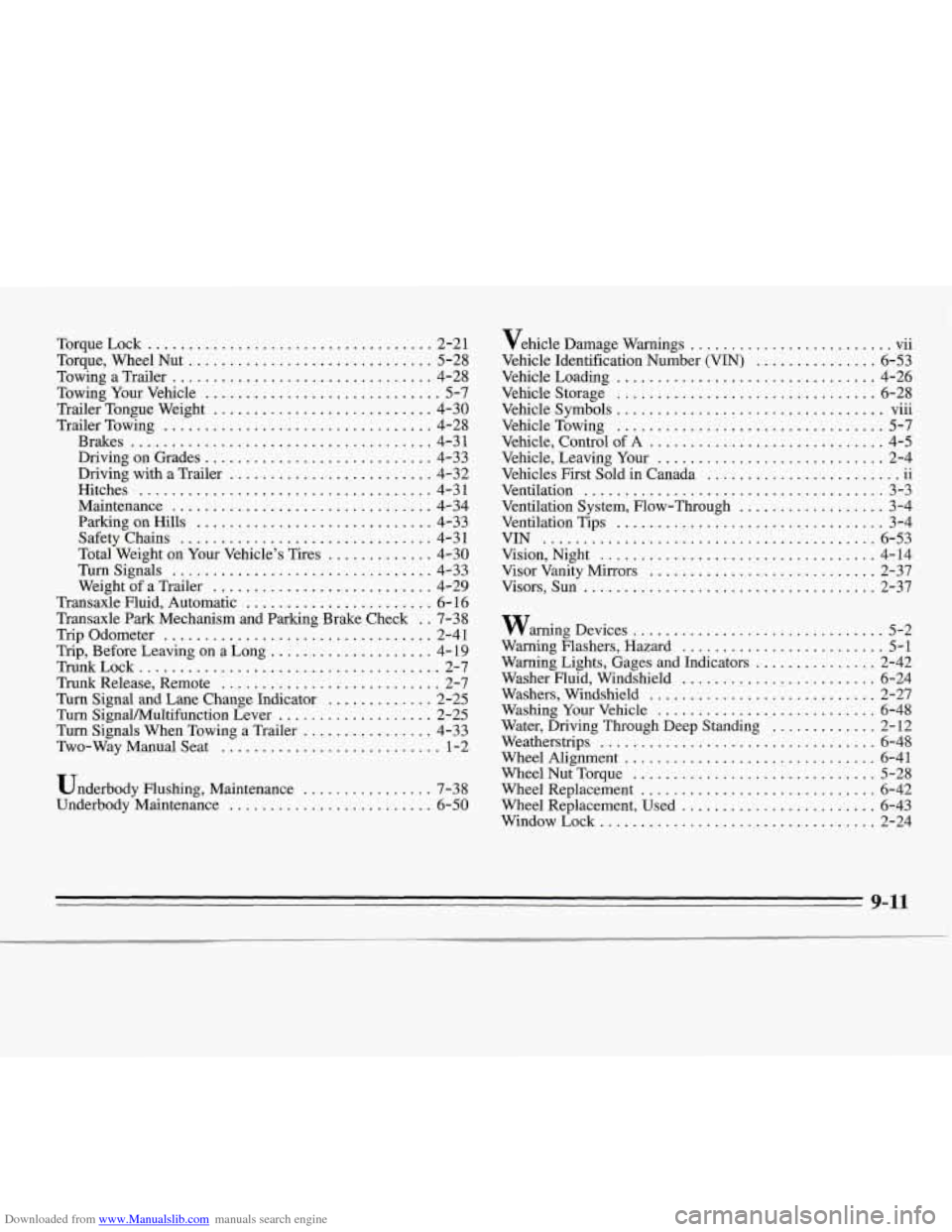
Downloaded from www.Manualslib.com manuals search engine TorqueLock ................................... 2-21
Towing Your Vehicle
............................. 5-7
TrailerTongue Weight
........................... 4-30
TrailerTowing
................................. 4-28
Brakes
..................................... 4-31
Driving on Grades
............................ 4-33
Driving with a Trailer
......................... 4-32
Hitches
.................................... 4-31
Maintenance
................................ 4-34
ParkingonHills
............................. 4-33
Safety Chains
............................... 4-3 1
Turnsignals ................................ 4-33
Weight
of a Trailer ........................... 4-29
Transaxle Fluid. Automatic
....................... 6- 16
Transaxle Park Mechanism and Parking Brake Check
. . 7-38
Trip Odometer
................................. 2-41
Trip. Before Leaving on a Long
.................... 4- 19
TrLlnkLock
..................................... 2-7
Trunk Release. Remote
........................... 2-7
Turn Signal and Lane Change Indicator
............. 2-25
Turn Signal/Multifunction Lever ................... 2-25
Torque.
Wheel Nut
.............................. 5-28
TowingaTrailer
................................ 4-28
Total Weight on Your Vehicle’s Tires
............. 4-30
Turn Signals When Towing a Trailer ................ 4-33
Two-WayManualSeat
........................... 1-2
Underbody Flushing. Maintenance
................ 7-38
Underbody Maintenance
......................... 6-50 vehicle
Damage Warnings
......................... vii
Vehicle Loading
................................ 4-26
Vehicle Storage
................................ 6-28
Vehicle Symbols
................................. VIU
Vehicle Towing ................................. 5-7
Vehicle. Control of A ............................. 4-5
Vehicle. Leaving Your
............................ 2-4
Vehicles
First Sold in Canada 11
Ventilation ..................................... 3-3
Ventilation System. Row-Through
.................. 3-4
VentilationTips
................................. 3-4
VIN ......................................... 6-53
Vision. Night
.................................. 4-14
Visor Vanity Mirrors ............................ 2-37
Visors. Sun .................................... 2-37
Vehicle
Identification Number
(VIN) ............... 6-53
...
.. ........................
warning Devices ............................... 5-2
Warning Rashers. Hazard
......................... 5-1
Washer Fluid. Windshield
........................ 6-24
Washers. Windshield
............................ 2-27
Washing Your Vehicle ........................... 6-48
Weatherstrips .................................. 6-48
Wheel Alignment
............................... 6-41
WheelNutTorque
.............................. 5-28
Wheel Replacement
............................. 6-42
Wheel Replacement. Used
........................ 6-43
WindowLock
.................................. 2-24
Warning
Lights. Gages and Indicators
............... 2-42
Water. Driving Through Deep Standing
............. 2-12